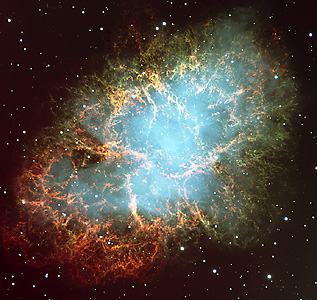Crab Nebula is a cloud of dust and gas in the constellation Taurus left behind by a supernova (exploding star). The Crab Nebula is about 6,500 light-years from Earth. One light-year equals the distance light travels in a vacuum in a year, about 5.88 trillion miles (9.46 trillion kilometers).

The Crab Nebula emits (gives off) detectable radiation in every part of the electromagnetic spectrum , from high-energy gamma rays and X rays, through visible light, to low-energy infrared and radio waves. A pulsar (rapidly spinning neutron star) at the center of the nebula formed from the core of the exploding star. Pulsars have strong magnetic fields and eject beams of electromagnetic radiation from their poles.
Loading the player...Crab Nebula
Thousands of years ago, a large star within the constellation Taurus exploded in a brilliant supernova. But because it was so distant, the light from the explosion reached Earth about 6,500 years later, in A.D. 1054. The supernova could be seen during daylight hours for more than three weeks. Chinese and Japanese astronomers observed and recorded the unusual occurrence. After about two years, the supernova faded from the night sky and was forgotten.
The English scientist John Bevis unknowingly discovered the remnant of the supernova in 1731. In the mid-1700’s, the French astronomer Charles Messier created a catalogue of non-stellar objects to aid astronomers in searching for comets. The nebula is the first object listed in Messier’s catalogue, therefore the first Messier object, designated M1. After the catalogue’s first publication, Bevis informed Messier of his prior discovery, and the second printing of Messier’s catalogue properly credited Bevis.
The remnant became known as the Crab Nebula from the work of the Irish astronomer William Parsons , Earl of Rosse, in the 1840’s. Lord Rosse studied the nebula with his telescope, which was at the time the most powerful ever built. He drew a picture of the nebula showing long filaments of dust extending from a central cloud. The drawing resembled a crab, so people began referring to the object as the Crab Nebula.
In the 1920’s, astronomers realized that the nebula was a remnant of the supernova of 1054. In 1968, a faint star with a featureless spectrum at the center of the cloud was confirmed to be the leftover core of the exploded star. It was found to emit pulses of light and radio waves 33 times per second. This discovery led astronomers to realize that pulsars were rotating neutron stars , since its fast rotation ruled out all other hypotheses. The United States’ Chandra X-ray Observatory studied this pulsar and created a time-lapse video of its activity.
Loading the player...X rays from the Crab Nebula
